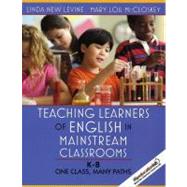
Dr. Linda New Levine is a consultant for public school teachers of language learning children and for programs for teaching English as a Foreign Language in both primary and secondary classrooms and holds a Masters in TESOL and a Ph.D. in Applied Linguistics from New York University. . She has been a teacher of English as a Second Language and a Staff Development Facilitator for the Bedford Central school district, New York. Levine was an adjunct assistant professor of ESL Methods and Materials for school-age children at Teachers College, Columbia University and has written Elementary ESL curriculum and conducted numerous workshops with ESL, EFL and mainstream teachers in the United States, Europe, Africa and Asia.
Dr. Mary Lou McCloskey, former President of TESOL, is Director of Teacher Education and Curriculum Development for Educo in Atlanta. As a consultant and author in the field of English language education, she has worked with teachers, teacher educators, and departments and ministries of education on five continents and in 35 of the 50 United States. Current projects include Teaching Tolerance through English, a project with teens and teachers in Central Europe; working as consultant to the FugeesFamily, a nonprofit group that serves school-age refugees in Atlanta, on ways to best develop literacy; and an anthology of contemporary literature for teens learning English. Author of many professional books and programs for learners, including On Our Way to English, Voices, Visions and McDougal Littell Literature. McCloskey considers her most important credential, however, her years of experience with multilingual, multicultural learners and teachers, from pre-school through postgraduate.
| List of Tables | |
| Figures, and Photos | |
| Introduction | |
| Language Acquisition and Language Learning in the Classroom | |
| What do we know about first language acquisition? | |
| Language acquisition is universal | |
| Language acquisition is natural | |
| Language acquisition does not require instruction What is the nature of the first language environment? | |
| Children are immersed in language | |
| Language is highly contextualized | |
| Language is a tool for purposeful use | |
| Children are physically active while learning languages | |
| Acquisition occurs within a social environment | |
| Children choose those aspects of language they wish to acquire | |
| Language acquisition is emotionally embedded | |
| Language acquisition is an integrated learning experience How is learning | |
| a second language in the classroom different from acquiring a first language? | |
| The acquisition and learning hypo | |
| The natural order hypothesis | |
| The input hypothesis | |
| The affective filter hypothesis | |
| The monitor hypothesis What are factors affecting acquisition? | |
| Limited language input | |
| Classroom organization | |
| High content and language level | |
| Academic and social language | |
| Negative Bias | |
| Cognition, age, and social/cultural differences | |
| Error correction | |
| Culture shock What strategies do ELLs use to acquire languages? | |
| Overgeneralization | |
| Table of Contents provided by Publisher. All Rights Reserved. |
The New copy of this book will include any supplemental materials advertised. Please check the title of the book to determine if it should include any access cards, study guides, lab manuals, CDs, etc.
The Used, Rental and eBook copies of this book are not guaranteed to include any supplemental materials. Typically, only the book itself is included. This is true even if the title states it includes any access cards, study guides, lab manuals, CDs, etc.